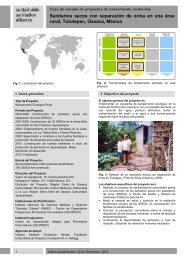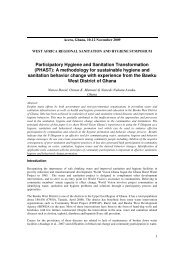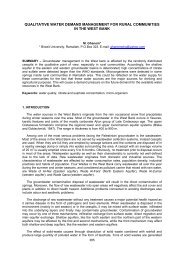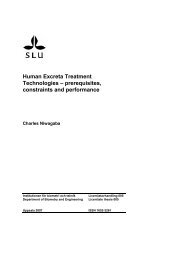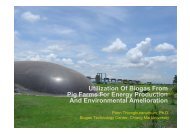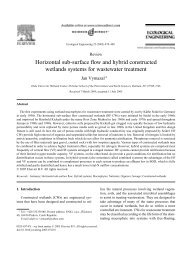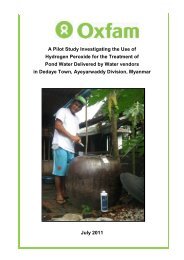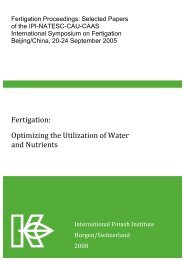Water conservation in textile industry - SSWM
Water conservation in textile industry - SSWM
Water conservation in textile industry - SSWM
You also want an ePaper? Increase the reach of your titles
YUMPU automatically turns print PDFs into web optimized ePapers that Google loves.
Top view wash<strong>in</strong>g tank<br />
Wash<strong>in</strong>g efficiency<br />
Wash<strong>in</strong>g process is characterized by its wash<strong>in</strong>g efficiency<br />
that is the amount of the compound that is removed divided by<br />
the total amount that could have been removed. Wash<strong>in</strong>g efficiency<br />
is not directly dependent on the amount of water used but<br />
is a function of:<br />
Temperature<br />
Speed of fabric <strong>in</strong> the wash<strong>in</strong>g range<br />
The properties of the fabric<br />
The properties of the wash<strong>in</strong>g range<br />
Temperature<br />
Textile<br />
<strong>Water</strong><br />
The temperature is important <strong>in</strong> wash<strong>in</strong>g because the temperature<br />
<strong>in</strong>fluences;<br />
a. The viscosity of water. At a lower viscosity water can better<br />
penetrate through the fabric and wash<strong>in</strong>g will become more<br />
effective.<br />
b. The aff<strong>in</strong>ity of compounds. At a higher temperature the aff<strong>in</strong>ity<br />
decreases and results <strong>in</strong> a better wash<strong>in</strong>g away of the<br />
unwanted components.<br />
c. Migration of the components from the <strong>in</strong>ner fibre to the<br />
water around the fiber. This migration is important for the<br />
total time the wash<strong>in</strong>g process will take.<br />
Speed of fabric <strong>in</strong> the wash<strong>in</strong>g range<br />
The speed of fabric <strong>in</strong> the wash<strong>in</strong>g range determ<strong>in</strong>es the<br />
amount of water that is hanged <strong>in</strong> the fabric by pass<strong>in</strong>g a roller <strong>in</strong><br />
the wash<strong>in</strong>g compartment. That is the liquor that was <strong>in</strong> the fabric<br />
before pass<strong>in</strong>g the roller with a high concentration of the<br />
unwanted components that is replaced by the wash<strong>in</strong>g liquor<br />
with a low concentration of the unwanted components.<br />
The properties of the fabric<br />
Figure 1 Scheme of a wash<strong>in</strong>g tank.<br />
The properties of fabric <strong>in</strong>fluence the wash<strong>in</strong>g effectiveness<br />
by the amount of water that can be pressed through the fabric<br />
dur<strong>in</strong>g wash<strong>in</strong>g. The openness of the fabric as well as the openness<br />
of yarn determ<strong>in</strong>es the length of the way the unwanted<br />
component has to migrate to the fluid that can be exchanged <strong>in</strong><br />
the wash<strong>in</strong>g process. In the wash<strong>in</strong>g process generally only very<br />
little water from the pores between the fibres is exchanged when<br />
the yarns are strongly twisted this will be practically zero. As<br />
migration is a very slow process it will take much longer for all the<br />
components to be washed out. The same holds more or less for<br />
thicker yarns and heavy weight fabrics.<br />
The properties of the wash<strong>in</strong>g range<br />
Side-view wash<strong>in</strong>g tank<br />
The effectiveness of the wash<strong>in</strong>g range is determ<strong>in</strong>ed by the<br />
number of wash<strong>in</strong>g tanks, the number of compartments <strong>in</strong> each<br />
tank, the diameter of the roller and the way the fabric is led through<br />
the wash<strong>in</strong>g range. The wash<strong>in</strong>g effectiveness can be improved by<br />
plac<strong>in</strong>g rollers on top of the top-rollers. This squeeze off the excess<br />
water <strong>in</strong> the fabric and a better exchange of wash<strong>in</strong>g liquid will be<br />
realized. Also at high speed these top rollers will prevent water to be<br />
taken with the fabric to the next compartment.<br />
<strong>Water</strong> <strong>conservation</strong> and reuse<br />
<strong>Water</strong> is expensive to buy, treat, and dispose. If the <strong>in</strong>dustry does<br />
not have water <strong>conservation</strong> program, its pour<strong>in</strong>g money downs the<br />
dra<strong>in</strong>. Now, water <strong>conservation</strong> and reuse are rapidly becom<strong>in</strong>g a<br />
necessity for <strong>textile</strong> <strong>in</strong>dustry. <strong>Water</strong> <strong>conservation</strong> and reuse can have<br />
tremendous benefits through decreased costs of purchased water and<br />
reduces costs for treatment of wastewaters. Prevention of discharge<br />
violations as a result of overload systems can be a significant <strong>in</strong>ducement<br />
for water <strong>conservation</strong> and reuse. By implement<strong>in</strong>g water <strong>conservation</strong><br />
and reuse programs, the decision to expand the treatment<br />
facilities can be placed on hold, and the available funds can then be<br />
used for expansion or improvements to process equipment.<br />
The first step <strong>in</strong> develop<strong>in</strong>g a water <strong>conservation</strong> and reuse<br />
program is to conduct a site survey to determ<strong>in</strong>e where and how<br />
water be<strong>in</strong>g used. It would be extremely helpful to develop a<br />
spreadsheet and/ or diagram of the water usage with specific<br />
details as shown below:<br />
Location and quantity of water usage.<br />
Temperature requirements.<br />
<strong>Water</strong> quality requirements, i.e. pH, hardness and limitations<br />
on solid content, must meet clean water standards, etc.<br />
Any special process requirements.<br />
<strong>Water</strong> <strong>conservation</strong> measures<br />
<strong>Water</strong> <strong>conservation</strong> measures lead to:<br />
Reduction <strong>in</strong> process<strong>in</strong>g cost.<br />
Reduction <strong>in</strong> wastewater treatment cost.<br />
Reduction <strong>in</strong> thermal energy consumption.<br />
Reduction <strong>in</strong> electrical energy consumption.<br />
Reduction <strong>in</strong> pollutants load.<br />
<strong>Water</strong> <strong>conservation</strong> significantly reduces effluent volume. A<br />
water <strong>conservation</strong> program can cut water consumption by up to<br />
30 percent or more, and the cost sav<strong>in</strong>gs can pay for the required<br />
materials <strong>in</strong> a very short time. S<strong>in</strong>ce the average plant has a large<br />
number of washers, the sav<strong>in</strong>gs can add up to thousands of<br />
rupees per year. Other reasons for large effluent volume is the<br />
choice of <strong>in</strong>efficient wash<strong>in</strong>g equipment, excessively long wash<strong>in</strong>g<br />
circles and use of fresh water at all po<strong>in</strong>ts of water use.<br />
The equipment used <strong>in</strong> a water <strong>conservation</strong> program is relatively<br />
<strong>in</strong>expensive, consist<strong>in</strong>g <strong>in</strong> most cases of valves, pip<strong>in</strong>g, small<br />
pumps, and tanks only. The operat<strong>in</strong>g costs for these systems are<br />
generally very low. Rout<strong>in</strong>e ma<strong>in</strong>tenance and, <strong>in</strong> some cases, electricity<br />
for the pumps, would be the major cost components.<br />
The payback period for a water <strong>conservation</strong> system will vary<br />
with the quantity of water saved, sewer fees, and costs for raw<br />
water and wastewater treatment. In addition to the direct cost sav<strong>in</strong>gs,<br />
a water <strong>conservation</strong> program can reduce the capital costs of<br />
any required end-of-pipe wastewater treatment system. Personnel<br />
from <strong>textile</strong> <strong>in</strong>dustry need to be aware of water <strong>conservation</strong> potential<br />
so they can help their organization realize the benefits.<br />
<strong>Water</strong> <strong>conservation</strong> methods for <strong>textile</strong> mills<br />
Numerous methods have been developed to conserve water<br />
at <strong>textile</strong> mills. Some of the techniques applicable to a wide variety<br />
of mills are discussed.<br />
Good Housekeep<strong>in</strong>g<br />
A reduction <strong>in</strong> water use of 10 to 30 percent can be accomplished<br />
by tak<strong>in</strong>g strict house keep<strong>in</strong>g measures. A walk through<br />
audit can uncover water waste <strong>in</strong> the form of:<br />
Hoses left runn<strong>in</strong>g.<br />
PTJ November 2009 49



